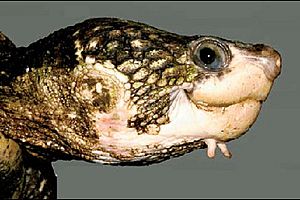White-throated snapping turtle facts for kids
Quick facts for kids White-throated snapping turtle |
|
|---|---|
 |
|
| Closeup of head, showing white throat | |
| Conservation status | |
| Scientific classification | |
| Genus: |
Elseya
|
| Species: |
albagula
|
| Synonyms | |
|
|
The white-throated snapping turtle (Elseya albagula) is one of the biggest freshwater turtles in the world. It can grow to about 45 centimeters (18 inches) long. This special turtle lives only in south-eastern Queensland, Australia. You can find it in the Burnett, Mary, and Fitzroy Rivers.
This turtle spends almost all its time in the water. It rarely comes out onto land. It mainly eats plants, like fruits, buds from river plants, algae, and other large water plants. Scientists first thought about this turtle as a new species in the 1960s. It was officially described in 2006. Its name, albagula, comes from Latin words meaning "white throat." This is because adult female turtles often have white patches on their throats.
What's in a Name?
The scientific name albagula tells us something special about this turtle. It comes from two Latin words. Alba means "white," and gula means "throat." So, the name means "white-throated." This name was chosen because adult female turtles often have white or cream-colored patches on their throats.
How to Spot One
The shell of the white-throated snapping turtle is shaped like a wide oval. It is a bit rounded at the front. Young turtles have small ridges, called keels, along their backs. The shell is usually dark brown to black and looks smooth. It does not have clear growth rings.
The bottom part of the shell, called the plastron, looks black in older turtles. This black color covers its true yellow or cream color. The plastron is also narrower than the top shell.
This turtle has a large, strong head. A complete shield covers its head. Its mouth has a strong, sharp edge. The head is usually dark brown or gray. Female turtles often have white or cream blotches on their throats.
Amazing Biology
White-throated snapping turtles have a very unique ability. They can breathe underwater using their cloaca. The cloaca is a special opening at the back of their body. This means they can take in oxygen from the water even when they are completely submerged. This ability is called cloacal respiration. Only a few other turtles and fish can do this.
Protecting These Turtles
The white-throated snapping turtle faces several big challenges. These challenges make it hard for them to survive.
- Nest Problems: Many turtle nests are destroyed. Animals like foxes dig up the eggs. Farm animals, such as cattle, can accidentally step on and crush the nests.
- River Dams: Most of the rivers where these turtles live now have dams. Dams change the water temperature, which can affect how the turtles reproduce. Dams also stop floods from reshaping sandbanks. These sandbanks are important places for turtles to lay their eggs. Over time, nesting sites can become unusable.
- Aging Populations: Many adult turtles are getting older, but not enough young turtles are surviving to replace them. This means the population is getting older overall.
- Dam Dangers: Turtles can be washed over dam walls. This fall can seriously injure or even kill them.
People are working to help these turtles. The Queensland government supports a "head start" program. In this program, turtle eggs are hatched in a safe place. The young turtles are then released into the wild and watched. Protecting existing nests also helps prevent them from being destroyed. There are also ideas for "turtleways" at dams. These would be special paths to help turtles get around the dams safely.


